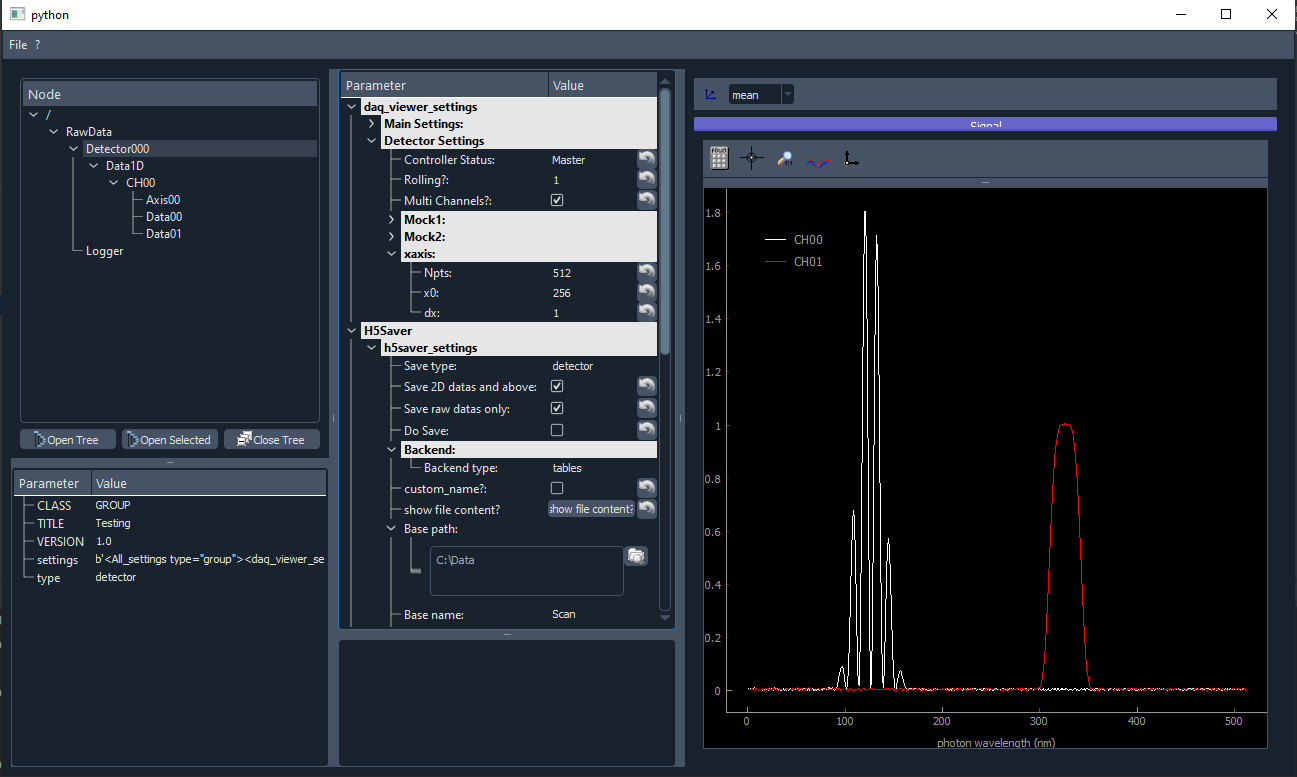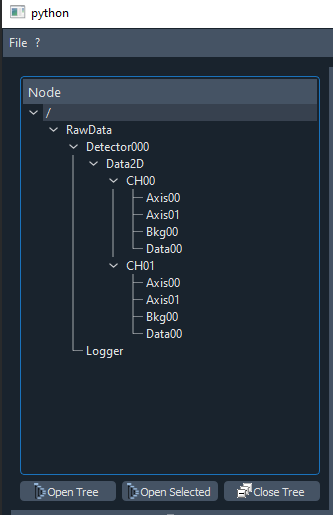3.6.3. Saving and loading data
Datas saved using PyMoDAQ, either the DAQ_Scan or the DAQ_Viewer modules or others, use a binary format known as hdf5. This format was originally developed to save big volume of datas from large instruments. Its structure is hierarchical (a bit as folder trees) and one can add metadata to all entries in the tree. For instance, the data type, shape but also some more complex info such as all the settings related to a module or an instrument plugin. This gives a unique file containing both data and metadata.
Python wrappers around the HDF5 library (hdf5 backends) are available, such as h5py or pytables (default one used by PyMoDAQ). For an even easier use, PyMoDAQ also has a dedicated object allowing a transparent use of any hdf5 backend: Hdf5 backends. It also has an object used for saving data: Low Level saving and browsing data: H5Browser.
These low level objects allow to interact with PyMoDAQ’s data and hdf5 file but because displaying and loading
correctly data need a specific layout and metadata in the hdf5 file, higher level objects should be systematically
used to save and load data. They insure that any data loaded from the hdf5 file will have a correct type:
DataWithAxes or DataToExport and that these data objects will be saved with the appropriate layout
and metadata to insure their reconstruction when loading. These objects are defined in the
pymodaq.utils.h5modules.data_saving module. Their specificity is described below but for a more detailed
description, see High Level saving/loading.
All these high level saving objects have under the hood a H5Saver object dealing with the actual saving. User
interface related to saving in PyMoDAQ all use the H5Saver ParameterTree and settings associated with to control
what/where/how to save data, see H5Saver.
3.6.3.1. DataSaver/DataLoader
Saving and loading data objects is a symmetrical action, therefore PyMoDAQ defines objects to do both. These objects
all derive from a base class allowing the manipulation of the node (DataManagement object), then the child class should define a data type and
will be responsible for saving and loading such data. Data type means here one of the three main type of
PyMoDAQ’s data system: Axis, DataWithAxes or DataToExport. These child objects are respectively:
AxisSaverLoader, DataSaverLoader and DataToExportSaver.
They all take as initial parameter a h5saver object (used to initialize a hdf5 file, see Low Level saving), then define specific methods to save their data type. Examples:
3.6.3.1.1. AxisSaverLoader
First I create a hdf5 file using the H5Saver (here H5SaverLowLevel because I’m not in a Qt event loop)
>>> import numpy as np
>>> from pathlib import Path
>>> from pymodaq.utils.data import Axis
>>> from pymodaq.utils.h5modules.saving import H5SaverLowLevel
>>> h5saver = H5SaverLowLevel()
>>> h5saver.init_file(Path('atemporaryfile.h5'))
Then I create the Axis object and its saver/loader
>>> from pymodaq.utils.h5modules.data_saving import AxisSaverLoader
>>> axis = Axis('myaxis', units='seconds', data=np.array([3,7,11,15]), index=0)
>>> axis_saver = AxisSaverLoader(h5saver)
I save the Axis object in the /RawData node (always created using H5Saver)
>>> axis_saver.add_axis('/RawData', axis)
/RawData/Axis00 (CARRAY) 'myaxis'
shape := (4,)
dtype := float64
I can check the content of the file:
>>> for node in h5saver.walk_nodes('/'):
>>> print(node)
/ (GROUP) 'PyMoDAQ file'
/RawData (GROUP) 'Data from PyMoDAQ modules'
/RawData/Logger (VLARRAY) ''
/RawData/Axis00 (CARRAY) 'myaxis'
And load back from it, an Axis object identical to the initial one (but not the same one)
>>> loaded_axis = axis_saver.load_axis('/RawData/Axis00')
>>> loaded_axis
Axis: <label: myaxis> - <units: seconds> - <index: 0>
>>> loaded_axis == axis
True
>>> loaded_axis is axis
False
3.6.3.1.2. DataSaverLoader
The DataSaverLoader object will behave similarly with DataWithAxes objects, introducing the methods:
add_data
load_data
with a slight asymmetry between the two if one want to load background subtracted data previously saved using the
specialized BkgSaver. This guy is identical to the DataSaverLoader except it considers the DataWithAxes
to be saved as background data type.
Here I create my data and background object:
>>> from pymodaq.utils.data import DataWithAxes, DataSource, DataDim, DataDistribution
>>> data = DataWithAxes('mydata', source=DataSource['raw'], dim=DataDim['Data2D'], \
distribution=DataDistribution['uniform'], data=[np.array([[1,2,3], [4,5,6]])],\
axes=[Axis('vaxis', index=0, data=np.array([-1, 1])),
Axis('haxis', index=1, data=np.array([10, 11, 12]))])
>>> bkg = data.deepcopy()
>>> data
<DataWithAxes, mydata, (|2, 3)>
>>> bkg
<DataWithAxes, mydata, (|2, 3)>
I add a detector node in the h5file:
>>> h5saver.add_det_group('/RawData', 'Example')
/RawData/Detector000 (GROUP) 'Example'
children := []
and save in this node the data:
>>> from pymodaq.utils.h5modules.data_saving import DataSaverLoader
>>> datasaver = DataSaverLoader(h5saver)
>>> datasaver.add_data('/RawData/Detector000', data)
and check the file content:
>>> for node in h5saver.walk_nodes('/'):
>>> print(node)
/ (GROUP) 'PyMoDAQ file'
/RawData (GROUP) 'Data from PyMoDAQ modules'
/Axis00 (CARRAY) 'myaxis'
/RawData/Logger (VLARRAY) ''
/RawData/Detector000 (GROUP) 'Example'
/RawData/Detector000/Data00 (CARRAY) 'mydata'
/RawData/Detector000/Axis00 (CARRAY) 'vaxis'
/RawData/Detector000/Axis01 (CARRAY) 'haxis'
It saved automatically the Axis objects associated with the data
>>> loaded_data = datasaver.load_data('/RawData/Detector000/Data00')
>>> loaded_data
<DataWithAxes, mydata, (|2, 3)>
>>> loaded_data == data
True
>>> loaded_data is data
False
Now about the background:
>>> from pymodaq.utils.h5modules.data_saving import BkgSaver
>>> bkgsaver = BkgSaver(h5saver)
>>> bkgsaver.add_data('/RawData/Detector000', data, save_axes=False)
no need to save the axes as they are shared between data and its background
>>> for node in h5saver.walk_nodes('/RawData/Detector000'):
>>> print(node)
/RawData/Detector000 (GROUP) 'Example'
/RawData/Detector000/Data00 (CARRAY) 'mydata'
/RawData/Detector000/Axis00 (CARRAY) 'vaxis'
/RawData/Detector000/Axis01 (CARRAY) 'haxis'
/RawData/Detector000/Bkg00 (CARRAY) 'mydata'
I now have a Bkg data type and can load data with or without bkg included:
>>> loaded_data_bkg = datasaver.load_data('/RawData/Detector000/Data00', with_bkg=True)
>>> loaded_data_bkg
<DataWithAxes, mydata, (|2, 3)>
>>> loaded_data_bkg == loaded_data
False
>>> loaded_data_bkg.data[0]
array([[0, 0, 0],
[0, 0, 0]])
>>> loaded_data.data[0]
array([[1, 2, 3],
[4, 5, 6]])
3.6.3.1.3. DataToExportSaver
Finally the same apply for DataToExport containing multiple DataWithAxes. Its associated
DataToExportSaver will save its data into different channel nodes themselves filtered by dimension.
The only difference here, is that it won’t be able to load the data back to a dte
Let’s say I create a DataToExport containing 0D, 1D and 2D DataWithAxes (see the tests file):
>>> dte = DataToExport(name='mybigdata', data=[data2D, data0D, data1D, data0Dbis])
>>> from pymodaq.utils.h5modules.data_saving import DataToExportSaver
>>> dte_saver = DataToExportSaver(h5saver)
>>> h5saver.add_det_group('/RawData', 'Example dte')
/RawData/Detector001 (GROUP) 'Example dte'
children := []
>>> dte_saver.add_data('/RawData/Detector001', dte)
>>> for node in h5saver.walk_nodes('/RawData/Detector001'):
>>> print(node)
/RawData/Detector001 (GROUP) 'Example dte'
/RawData/Detector001/Data0D (GROUP) ''
/RawData/Detector001/Data1D (GROUP) ''
/RawData/Detector001/Data2D (GROUP) ''
/RawData/Detector001/Data0D/CH00 (GROUP) 'mydata0D'
/RawData/Detector001/Data0D/CH01 (GROUP) 'mydata0Dbis'
/RawData/Detector001/Data1D/CH00 (GROUP) 'mydata1D'
/RawData/Detector001/Data2D/CH00 (GROUP) 'mydata2D'
/RawData/Detector001/Data2D/CH00/Data00 (CARRAY) 'mydata2D'
/RawData/Detector001/Data2D/CH00/Data01 (CARRAY) 'mydata2D'
/RawData/Detector001/Data2D/CH00/Axis00 (CARRAY) 'myaxis0'
/RawData/Detector001/Data2D/CH00/Axis01 (CARRAY) 'myaxis1'
/RawData/Detector001/Data1D/CH00/Data00 (CARRAY) 'mydata1D'
/RawData/Detector001/Data1D/CH00/Data01 (CARRAY) 'mydata1D'
/RawData/Detector001/Data1D/CH00/Axis00 (CARRAY) 'myaxis0'
/RawData/Detector001/Data0D/CH00/Data00 (CARRAY) 'mydata0D'
/RawData/Detector001/Data0D/CH00/Data01 (CARRAY) 'mydata0D'
/RawData/Detector001/Data0D/CH01/Data00 (CARRAY) 'mydata0Dbis'
/RawData/Detector001/Data0D/CH01/Data01 (CARRAY) 'mydata0Dbis'
Here a bunch of nodes has been created to store all the data present in the dte object.
3.6.3.1.4. DataLoader
If one want to load several nodes at ones or include the navigation axes saved at the root of the nodes, one should
use the DataLoader that has methods to load one DataWithAxes (including eventual navigation axes) or a bunch of it
into a DataToExport:
load_data ->
DataWithAxesload_all ->
DataToExport
3.6.3.1.5. Special DataSaver
Some more dedicated objects are derived from the objects above. They allow to add Extended arrays (arrays that will be populated after creation, for instance for a scan) and Enlargeable arrays (whose final length is not known at the moment of creation, for instance when logging or continuously saving) see Specific data class saver/loader.
3.6.3.2. Module Savers
Data saved from the various PyMoDAQ’s modules should follow a particular layout. For instance grouped in a Detector
node for data from the DAQ_Viewer modules or a Scan node for data from the DAQ_Scan module. This node also has metadata such as the settings of the DAQ_Viewer
at the time when the data have been saved. Special layouts and special saver objects are available for each module
able to save data: DAQ Viewer, DAQ Move, DAQ Scan and DAQ Logger.
See Module savers for the related objects.
All of these objects inherit from the ModuleSaver base class that implements common methods for all savers. Specific
saver, such as the DetectorSaver then defines a GroupType:
class GroupType(BaseEnum):
detector = 0
actuator = 1
data = 2
ch = 3
scan = 4
external_h5 = 5
data_dim = 6
data_logger = 7
This correspond to a particular type of group node in the h5 file. For what we are discussing the relevant group
types are detector, actuator, scan and data_logger. For the DetectorSaver the group type is therefore:
detector. Once instanced these objects can be attributed with a given
H5Saver instance. for instance, when saving snapshots from the DAQ_Viewer, this code is called:
path = 'a/custom/path/for/a/hdf5/file.h5'
h5saver = H5Saver(save_type='detector')
h5saver.init_file(update_h5=True, custom_naming=False, addhoc_file_path=path)
self.module_and_data_saver = module_saving.DetectorSaver(self)
self.module_and_data_saver.h5saver = h5saver
Then self.module_and_data_saver will automatically create a dedicated group node in the h5 file.
Then it can call specific methods to add properly formatted data in the hdf5 file:
detector_node = self.module_and_data_saver.get_set_node(where)
self.module_and_data_saver.add_data(detector_node, data, **kwargs)
where data is a DataToExport object (containing possibly multiple DataWithAxes objects). The content of such a file
can be displayed using the H5Browser as shown on figure Fig. 3.55

Fig. 3.55 HDF5 file content containing a single DataWithAxes (with two channels) saved using the DetectorSaver object
One clearly see the layout with the Detector000 group node (with the setting metadata displayed on the right in a
ParameterTree), the grouping of data by dimensionality, both channels having the same Axis grouped in the
CH00 group node. Both channels are plotted on the right panel in a Viewer1D object.
If multiple DataWithAxes where contained in the DataToExport they would be stored within CH00 and CH01
group nodes as shown in Fig. 3.56 together with their axes and even here
with their background

Fig. 3.56 HDF5 file content containing two DataWithAxes (with one channel each) saved using the DetectorSaver object.
They are stored within CH00 and CH01 group nodes each with their axes and even here with their background.
The code used to add the background is:
self.module_and_data_saver.add_bkg(detector_node, self._bkg)
where self._bkg is a DataToExport similar to the one we saved but containing background data.